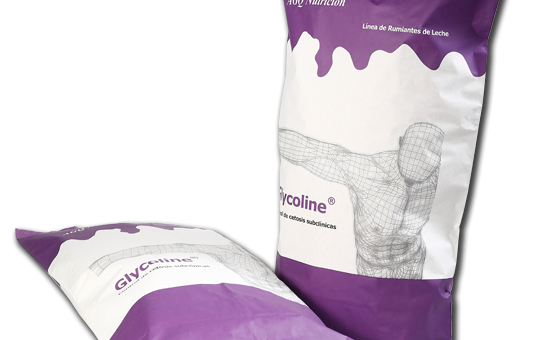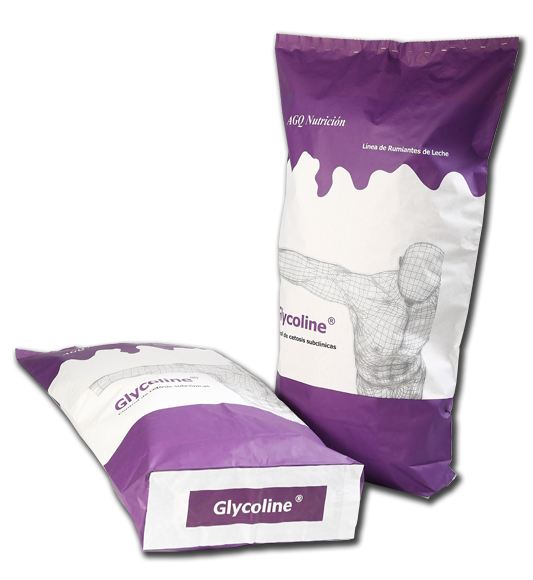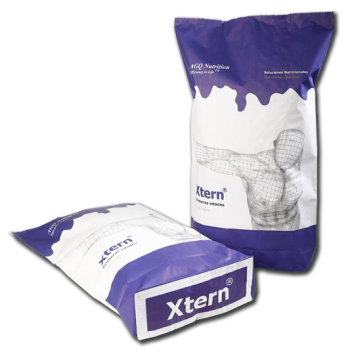
Glycoline
Glycoline
Ketosis & Negative Energy Balance Control
Ketosis is a common issue in both the pre-calving and post-calving phases, often leading to problems such as decreased feed intake, poor fertility, and reduced milk production. Glycoline, a specially formulated mixture containing glucose precursors and essential gluconeogenic cofactors, serves as an effective solution. By reducing fat mobilization, preventing fatty liver, and curbing ketone production, Glycoline plays a crucial role in preventing ketosis and ensuring a successful transition into lactation.
Glycoline is designed to stimulate feed consumption by addressing ketone levels in the bloodstream and maintaining optimal blood glucose levels, both before and after calving.
Specifications

KETOSIS & NEGATIVE ENERGY BALANCE EXPLAINED
Ketosis and Negative Energy Balance (NEB) are key concerns in dairy farming, especially during the pre-calving and post-calving phases. These metabolic issues significantly impact cow health and productivity.
Negative Energy Balance occurs when cows expend more energy than they obtain from their diet, with pre-calving cows facing elevated energy demands due to the transition from late pregnancy to early lactation. Fat mobilization plays a crucial role, releasing fatty acids converted into ketone bodies when energy intake is insufficient, leading to ketosis.
The consequences are notable: decreased Dry Matter Intake (DMI), reduced milk production, and impaired reproductive cycles. Preventive measures and proper nutrition are essential for managing these issues, ensuring the well-being of dairy cows and farm sustainability.
- Pre-Calving Risk: Dairy cows are particularly vulnerable to NEB and ketosis before calving due to increased energy demands during pregnancy.
- Fat Mobilization: In response to inadequate energy intake, cows break down body fat reserves, releasing fatty acids.
- Ketone Body Production: The liver converts excess fatty acids into ketone bodies, such as acetone, acetoacetate, and beta-hydroxybutyrate.
- Depressed DMI: Negative Energy Balance often results from depressed Dry Matter Intake (DMI), causing an energy deficit.
- Depressed Milk Production: NEB can lead to reduced milk production as the cow’s energy is diverted away from milk synthesis.
- Impaired Ovarian Cycling: Ketosis and NEB can disrupt the cow’s reproductive cycle, causing fertility issues.
The consequences of ketosis and NEB in dairy cows can be profound:
- Health Issues: Ketosis can lead to various metabolic disorders, such as fatty liver and displaced abomasum.
- Decreased Productivity: Reduced milk production negatively impacts farm profitability.
- Fertility Problems: Impaired ovarian cycling can result in longer calving intervals and decreased reproductive efficiency.
- Financial Loss: Treating and managing these conditions incurs additional costs for farmers.
- Animal Welfare Concerns: Health issues can lead to decreased well-being for the affected cows.
Addressing these issues through proper nutrition, management, and preventive measures is crucial to maintaining the health and productivity of dairy herds.
KEY FACTS
Overview
- Ketosis and Negative Energy Balance (NEB) pose critical challenges for dairy cows.
- These metabolic issues are particularly prevalent during pre-calving and post-calving phases.
- Effective management is crucial for cow well-being and sustainable farm operations.
Triggers
- Pre-calving cows are at a higher risk due to increased energy demands.
- Fat mobilization and ketone body production result from insufficient energy intake.
- This can lead to reduced feed intake, lower milk production, and disrupted reproductive cycles.
Impacts
- Ketosis and NEB often reduce milk production.
- Longer calving intervals and decreased fertility can occur.
- Vigilant monitoring and proper nutrition are key to managing these issues.
BENEFITS OF GLYCOLINE
Reduce BEN
One of the foremost challenges in dairy farming is tackling Negative Energy Balance (NEB). Glycoline™ offers an effective solution to minimise NEB in dairy cows. By optimising energy utilisation and reducing metabolic imbalances, Glycoline™ ensures that cows maintain a healthier balance throughout their lactation cycle.
- Significantly reduces the incidence of Negative Energy Balance (NEB).
- Promotes better energy utilization, enhancing overall cow health.
- Reduces the risk of metabolic disorders associated with NEB.
Increase Milk
Milk production is the lifeblood of the dairy industry, and Glycoline™ plays a pivotal role in maximizing it. With Glycoline™, dairy farmers can expect increased milk yields and greater profitability, ensuring that their dairy operations thrive.
- Increase milk production, with higher peaks and more persistent lactation curves.
- Enhances the quantity of milk, leading to improved Cost over Income over Feed Cost (CIFC) for dairy farmers.
- Enhances the overall efficiency of the dairy herd.
Improve Fertility
Rebooting a cow’s reproductive cycle is vital for successful dairy farming. Glycoline™ offers a comprehensive solution by reducing the length of the post-partum anovulatory interval (PPAI) or calving to first heat. It also optimizes the cow’s peak milk production and lactation persistence while minimizing acute weight and body condition score (BCS) loss.
- Drastically shortens the post-partum anovulatory interval (PPAI), ensuring a quicker return to fertility.
- Enhances lifetime milk yield while preventing inefficient, overextended lactations caused by late conception dates within the yearly optimal cycle.
- Effectively mitigates acute weight and body condition score (BCS) loss, ensuring healthier cows ready for their next reproductive cycle.
Key Scientific Excerpts
"Ketosis reaches a prevalence of 20% during early postpartum, with economic losses estimated up to €250 per case/year, doubling if associated diseases are considered"
Ketosis prevalence,
(Lei & Simões, 2021)"The overall prevalence of subclinical ketosis in European dairy farms was 21.8%, with cows having 1.5, 9.5, and 5.0 times greater odds of developing metritis, clinical ketosis, and displaced abomasum, respectively"
Prevalence of Subclinical Ketosis,
(Suthar et al., 2013)"Analysis of over 1 million test day records showed the highest decrease in daily milk yield due to subclinical ketosis was 4.21 kg/day in first-parity cows and 3.72 kg/day in cows with more than four lactations" (Gantner et al., 2016).
NEB effect on Milk Yield,
"In Western European dairy herds, the prevalence of ketosis was 39%, with significant variation among countries. Management systems and fresh cow clinical conditions were identified as associated factors" (Berge & Vertenten, 2014).
Prevalence of Ketosis in Europe,
The overall prevalence of subclinical ketosis (SCK) in European dairy farms was 21.8%, with cows having 1.5, 9.5, and 5.0 times greater odds of developing metritis, clinical ketosis, and displaced abomasum, respectively. (Suthar et al., 2013).
Prevalence in Ketosis,
With regard to fertility to AI, there is a strong positive association between early commencement of postpartum ovulatory cycles and subsequent pregnancy, ensures a good start to lactation, increasing feed efficiency and milk production, particularly during heat stress
NEB on Reproduction of Dairy Cows,
(Butler, 2000; Galvao et al., 2010)With regard to fertility to AI, there is a strong positive association between early commencement of postpartum ovulatory cycles and subsequent pregnancy (Butler, 2000; Galvao et al., 2010). This important relationship has focused research attention on the regulation and re-initiation of ovarian activity and ovulatory cycles in early lactation prior to the breeding period. Energy balance, re-initiation of ovarian activity, and metabolic health status are inter-connected in transition cows.

